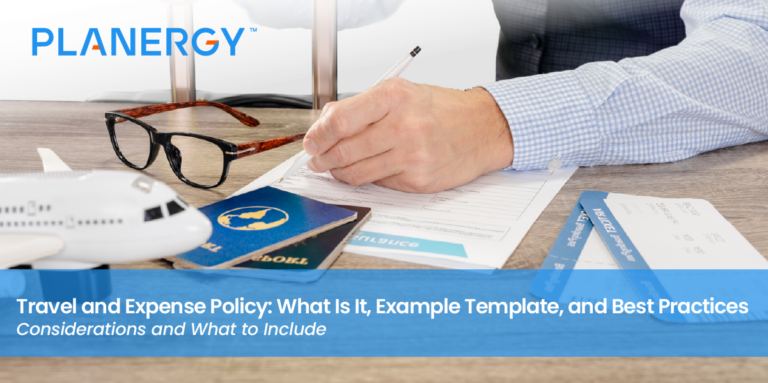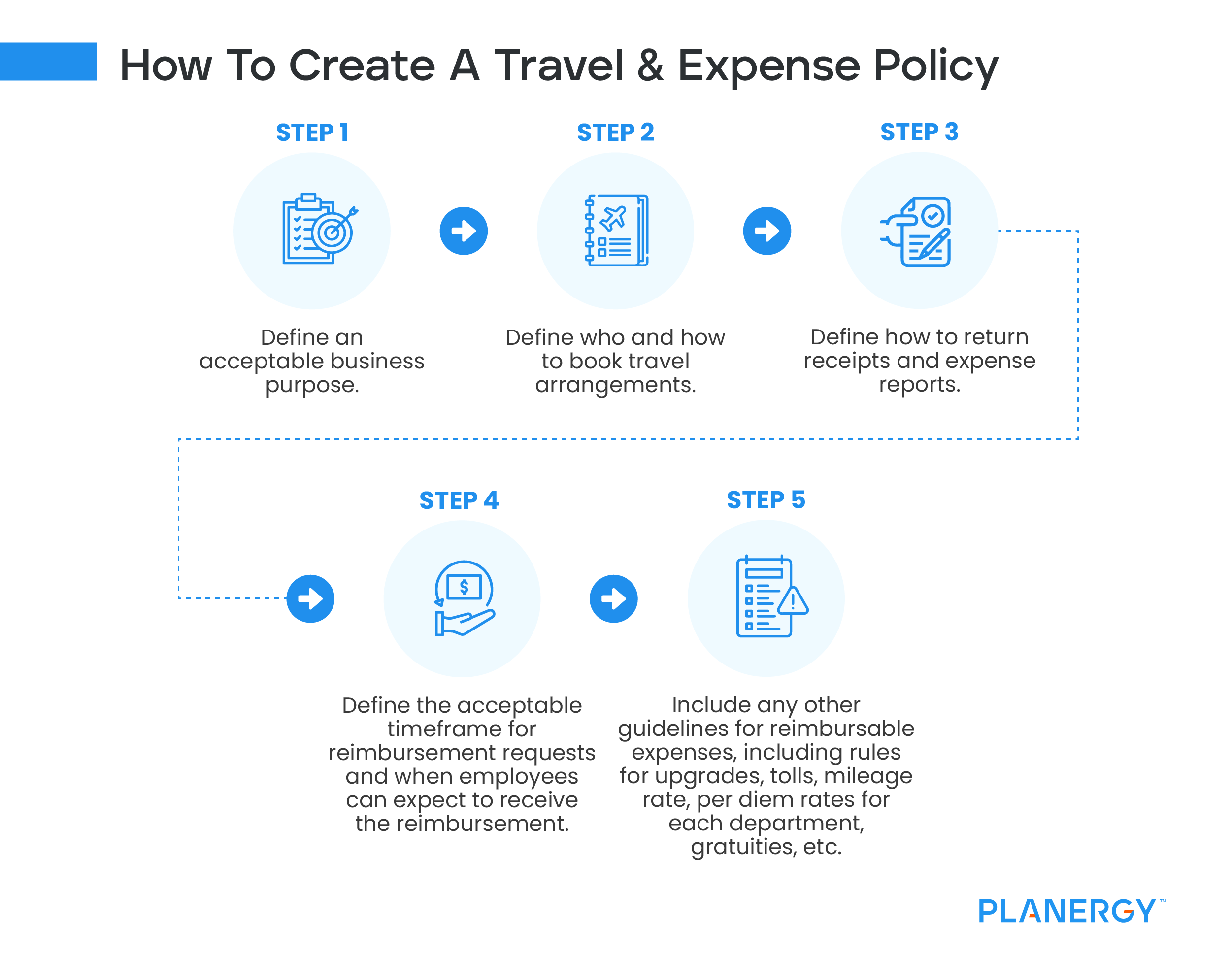-
Introduction
Use this section to let your staff know your policy isn’t just more red tape – it’s designed to keep them safe, keep things fair, reduce confusion, and ultimately, save time.
Depending on your organization, you may have multiple policies – different policies depending on the department or type of employee. If that’s the case, your introduction should also include who the policy is for.
-
Travel Booking Process
Use this section to include everything your team needs to know about where and how to book travel – whether someone will make the arrangements for them or they will make the arrangements themselves.
Here’s where you outline:
-
How to Book Travel
Include your process, method, and platform for booking any company travel. It’s ideal to use a platform to allow employees to book options within policy. If you do, include the name of the platform.
If employees cannot book their own travel, include the name and contact information of the travel agency or company employee who will take care of booking the travel arrangements.
-
Approval Process
Include the details of the approval process, especially for senior management. The approval process for the C-Suite and senior employees may vary from others.
-
Leisure Extensions
If you want business travelers to be able to extend their trip to the weekend or use vacation days for additional time, include rules around these extensions.
Include details about the allowable difference for return flights and what separates personal expenses from business ones.
Make it known that they will incur additional costs that your company will not reimburse.
-
Loyalty Program Usage
Many companies don’t let employees accrue personal loyalty points on business travels.
But, if you trust your team to do the right thing, include a line that says something along the lines of, “Employees must not choose more expensive travel options for the sole purpose of gaining additional loyalty points.”
-
Traveling with Non-Employees
Expenses related to traveling with spouses or other family members, pets, or friends outside of the company aren’t generally eligible for reimbursement.
If any situations are subject to approval, such as attending a networking event, outline these possibilities.
-
Business Expense Categories
This is a crucial part of your template as it outlines what employees can expense. This is key to keeping things as cost-effective as possible.
Air Travel
- Preferred vendors
- Approved tools or methods of booking
- Rules regarding allowed travel class
- How many days in advance must flights be booked for both domestic and international travel.
Accommodations
- Preferred vendors and negotiated rates, if any
- Approved tools or methods of booking
- Maximum nightly rate
- Rules regarding standard rooms and upgrades – for instance, upgraded rooms are only allowed when standard is completely booked
- Reimbursable costs – parking, etc.
- Rules for booking house-sharing or apartment rentals
Rental and Personal Vehicles
- Allowed types of rental car class
- Number of employees expected to share a vehicle when traveling together
- Mileage reimbursement rate, per mile or kilometer
Rail Travel
- Approved tools or methods of booking
- Type of ticket allowed
Taxis and Ride-Sharing Services
- Maximum amount per transaction
- When use of these services is allowed (particularly in areas where airport shuttles or public transport isn’t practical)
Events and Conferences
- Reimbursement process for registration if it was not pre-paid.
- Process for other event or conference-related expenses, such as meals or things not included in the registration cost
Meals, Travel, and Entertainment
- The maximum reimbursable amount for each breakfast
- The maximum reimbursable amount for each lunch
- The maximum reimbursable amount for each dinner
- Or a daily maximum or per diem
- Personal meal expenses throughout the trip
- Rules for business meals
- Rules for client entertainment expenses, including maximum amounts and what’s allowed
Personal Telephone Use
- The amount of the cell phone bill or percentage that can be reimbursed during the employee’s travel period. Include whether calls made for personal reasons will be covered.
- Whether or not theft of or damage to the personal phone is reimbursable during business travel, and if so, the maximum allowable amount.
-
Non-Reimbursable Purchases
Keep a list of the things your company won’t reimburse, so people know ahead of time that certain things will come out of pocket at their expense.
Get input for your chief financial officer and the employees who travel most often to determine what’s far to exclude across the board.
It should be clear that your business expense policy will only cover travel-related and business-related expenses and nothing else.
Examples include:
- In-flight purchases
- Childcare or pet boarding
- Costs related to non-employee travel
- Laundry and dry cleaning
- Room service
- Damage to personal vehicles
- Airline ticket change fees
- Traffic violations or parking tickets
- Airline club memberships
- Excess baggage fees
- Premium or luxury car rentals
- Rental car insurance coverage
- Minibar or alcoholic beverages
- Online entertainment, movies, newspapers, etc.
- Clothing and toiletries
-
Expense Reporting and Reimbursement Process
This section should cover the following:
- The expensing tool to use
- The items that do not need to be added to the expense tool (such as if the trip is booked within the approved booking tool)
- Who to submit reports to
- What to include in the reimbursement requests
- Deadline for request submissions
- Typical processing time for requests
- Policy on personal credit card use
-
Travel Support, Safety, and Duty of Care
Your policy needs to be something people want to read. It must include information they need to know to familiarize themselves with.
Your staff wants to stay safe while traveling, so including information about their safety and what to do if an emergency arises is key.
Tracking Whereabouts
Let your employees know that when they book with your approved tools or methods, the trip is tracked, so if there is an emergency, you’ll take steps to evacuate them. If you don’t know where they are, you can’t assist.
Include the approved tool’s name, and what they need to do to ensure their trip is tracked if they cannot book within the tool for a valid reason.
Travel Support
Include information about who to call if there are trip changes or cancelations. Provide contact information for the travel support provider, such as email address, phone number, etc.
Emergencies
If an emergency arises, there should be information about who to contact, including your travel insurance policy information. Include employee and vendor contact information for the point of contact in an emergency.





